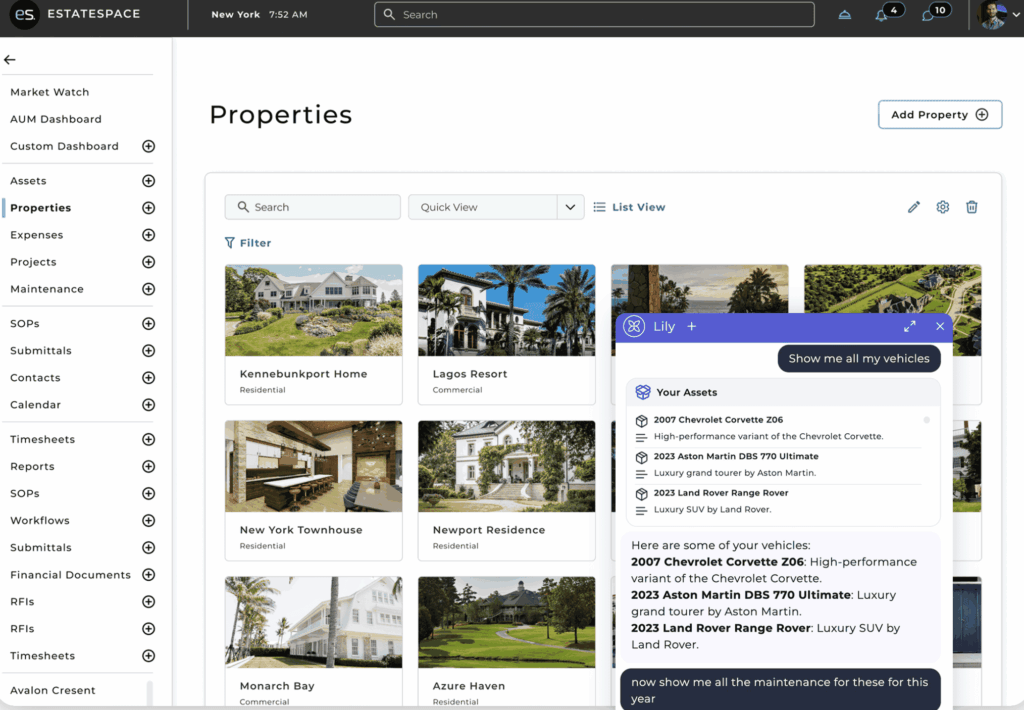Running high-value properties, estates, and complex asset portfolios requires foresight, precision, and coordination. Whether it’s ensuring vendors meet service deadlines, managing staff schedules, or keeping essential records in one place, the role demands constant attention. In many cases, technology in estate operations changes how professionals handle these needs. It replaces scattered systems with a connected, easy-to-use approach.
The Reality of Estate and Asset Operations
For many estate and asset professionals, each day blends complexity with urgency. Often, important details hide in long email chains, text messages, or separate spreadsheets. For example, a maintenance request might be tracked in one place. However, an invoice for that same service could be stored elsewhere. Over time, these gaps reduce productivity, raise costs, and create stress for staff and principals alike.
One estate manager described a common challenge: a last-minute request from a principal to prepare a residence for an unplanned visit. Staff rushed to arrange housekeeping, catering, and transportation. However, missing vendor contacts and unclear task ownership caused delays. By contrast, using technology in estate operations allows teams to work from one shared source of truth. Therefore, mistakes are avoided, and time is saved.
How Different Stakeholders Benefit
For family offices, adopting modern tools ensures that real estate and asset oversight fits into the complete wealth picture. Without central data, teams risk advising clients with incomplete information. Family office leaders can use dedicated platforms to combine property details, budgets, and service schedules. In this way, technology in estate operations becomes a core part of strategic planning. Moreover, it supports transparent reporting and better-informed decisions.
For asset managers, the benefits are equally strong. They spend less time chasing paperwork and more time on client strategy. As a result, client relationships deepen, and portfolio performance improves. Meanwhile, for owner’s representatives, technology bridges the gap between construction completion and operational readiness. It also preserves project history and avoids costly rework.
Common Challenges for Estate Professionals
Key obstacles include:
- Fragmented communication – Switching between texts, emails, and calls increases the risk of missed deadlines.
- Scattered document storage – Contracts, warranties, and reports often live in multiple locations.
- Reactive maintenance cycles – Without planning ahead, small issues can turn into expensive repairs.
- Hidden expenses – Without real-time insight into invoices and budgets, teams struggle to make quick decisions.
The concierge and lifestyle management side adds another layer of detail. Coordinating travel, events, or luxury services requires precise timing. When managed with separate tools, these services are more prone to errors. Here again, technology in estate operations allows for smoother collaboration and fewer oversights. Furthermore, it helps ensure every step is documented and repeatable for future needs.

The Role of AI in Estate Operations
Today, AI tools make it possible to tag, search, and find asset and document records in seconds. Invoices can match to vendor contracts automatically. Furthermore, maintenance requests can be sorted by urgency and asset value. As noted in Key Considerations of AI in Asset and Wealth Management, AI supports human oversight rather than replacing it. Consequently, professionals can focus on the most important decisions.
For those exploring solutions, the EstateSpace Product Overview shows how shared workflows, secure permissions, and real-time reports remove common pain points. Ultimately, technology in estate operations makes it easier to deliver consistent service while keeping sensitive information secure.
Why Technology Matters for Every Stakeholder
Bringing technology into estate operations benefits all parties:
- Principals gain clarity without managing every step.
- Staff work with fewer obstacles and clearer priorities.
- Vendors receive accurate instructions, improving delivery and accountability.
Inside a family office, presenting new technology to principals should highlight privacy, cost control, and property value. Consequently, it becomes easier to gain buy-in.
Asset managers see the benefit of unified data for faster reporting and better portfolio growth. Project managers also gain value by transferring all build documentation into operations for long-term use. Specifically, this ensures that historical records are always available for reference. In every case, technology in estate operations aligns daily actions with strategic outcomes.
Practical Steps to Improve Estate Operations
To get started:
- Review workflows to find duplicate or slow steps.
- Store key documents in one secure, searchable location.
- Use task management tools that assign clear owners and deadlines.
- Link reports to both operational activity and financial results.
- Create onboarding steps that pass knowledge to new staff.
The move to technology in estate operations builds more than efficiency — it builds stability. As estates expand, being able to maintain smooth operations through staff changes, growth, or sudden events is critical. In turn, this protects both asset value and service quality.
For a broader look at the role of operations in estate planning, see Understanding Estate Management: Beyond Household Operations. This perspective reinforces why technology is now essential to keeping standards high.
In the end, principals want peace of mind, professionals want structure, and both want results. Technology in estate operations creates a clear framework where everyone is informed, aligned, and able to focus on what matters most.
To see how this can work for your team, Learn Our Approach.



